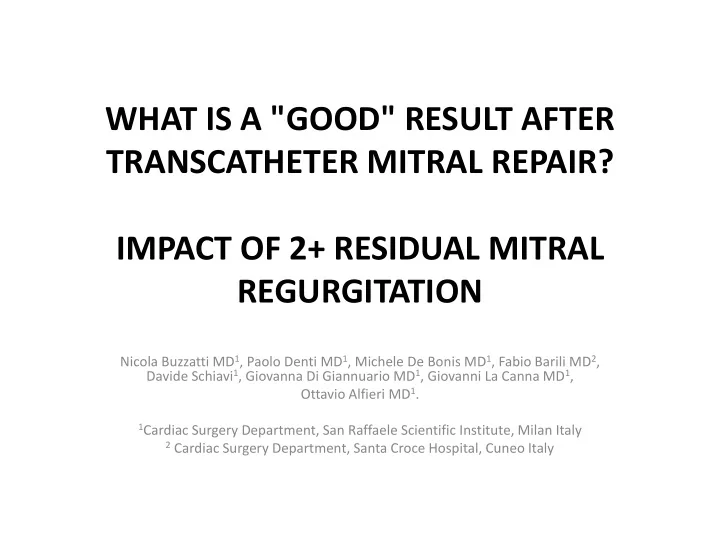

WHAT IS A "GOOD" RESULT AFTER TRANSCATHETER MITRAL REPAIR? IMPACT OF 2+ RESIDUAL MITRAL REGURGITATION Nicola Buzzatti MD 1 , Paolo Denti MD 1 , Michele De Bonis MD 1 , Fabio Barili MD 2 , Davide Schiavi 1 , Giovanna Di Giannuario MD 1 , Giovanni La Canna MD 1 , Ottavio Alfieri MD 1 . 1 Cardiac Surgery Department, San Raffaele Scientific Institute, Milan Italy 2 Cardiac Surgery Department, Santa Croce Hospital, Cuneo Italy
Disclosures • None
Background Grigioni et al, Circulation 2001 De Bonis et al, JTCVS 2012 ACCESS-EU Registry, Maisano et al, JACC 2013
Methods • OSR MitraClip patients ’ pathway: – Anatomy selection by TOE – Risk selection and overall judgment by Heart-Team approach – Standardized prospective in-hospital data collection – Enrollement in a dedicated follow-up out-patient clinic MR grading according to EACTS/ESC Guidelines: 1+ mild, 2+ moderate, 3+ medium, 4+ severe 243 consecutive symptomatic high-risk patients from October 2008 to December 2014 Acute residual MR ≤2+ Acute residual MR ≥3+ n=223 (91.8%) n=20 (8.2%) Excluded from the study Residual MR ≤1+ Residual MR 2+ n=159 (65.4%) n=64 (26.4%) Study group
Baseline clinical features
Baseline echo features
Follow-up results Follow-up 100% complete Median follow-up time 20.5 months (IQR 8-36 up to 75 months) • 30-day mortality 4/223 (1.8%) • Overall follow-up survival 50.4 ±7.5% at 56 months • Cardiac death – 27/46 (58.7%) in FMR group – 3/15 (20.0%) in DMR group
Freedom from cardiac death in FMR 88.9 ± 3.6% 48.4 ± 10.2% 28
Follow-up NYHA class in FMR p=0.002 Paired data from 141 (91.0%) patients * In DMR, NYHA III was found in only 3 of 2+MR vs 4 of ≤1+MR patients (p=0.47)
MR ≥ 3+ RECURRENCE FMR DMR 92.8 ± 4.0% 94.7 ± 2.3% 68.0 ±10.9% 48.2 ± 9.4% 9 Residual 2+ was the only independent predictor of MR recurrence: p<0.001, HR 8.3 (CI 3.6-19.5) p=0.005, HR 5.5 (CI 1.6-18.3)
Is it only a matter of severe MR recurrence? Does 2+MR per se have an impact? 95.6±2.1 p=0.045 71.2±1.1 Multivariable COX prediction p value HR CI for cardiac death (n=127) Age 0.026 1.07 1.01-1.13 Pre-op LVEDD 0.001 1.19 1.08-1.31 Pre-op sPAP 0.021 1.05 1.01-1.09 Residual 2+MR 0.038 3.31 1.07-10.20
Study limitations • Small numbers • Short follow-up • Single centre • Learning curve? • MR quantification in the double-orifice setting remains challenging
Conclusions • Residual 2+MR was associated with increased early MR recurrence in both FMR and DMR • In FMR it also predicted reduced mid-term survival and worse symtoms • Reduction of MR to 2+ MAY still be acceptable is some high-risk patients with short life expectancy? – Which 2+MR will remain stable? – Which 2+MR will get worse? • Better efficacy should be achieved be transcatheter mitral repair technologies before expanding indications to mid/low-risk patients
Recommend
More recommend